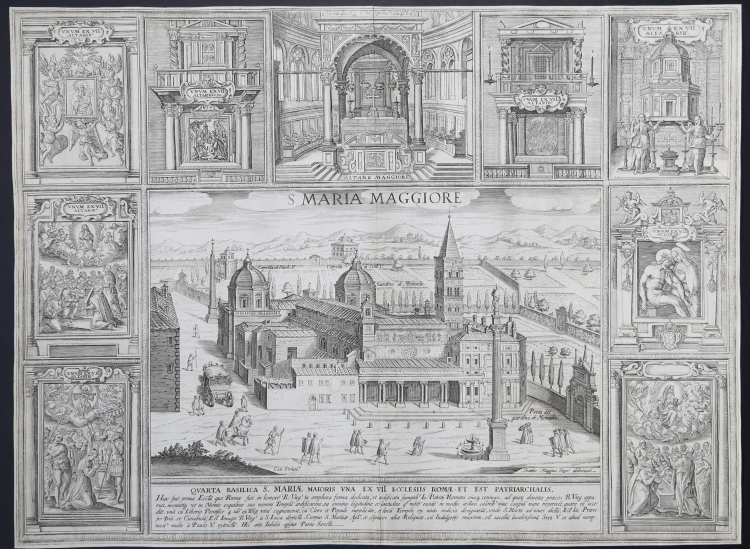- New



| Reference: | S50226 |
| Author | Mattheus GREUTER |
| Year: | 1625 |
| Zone: | Santa Maria Maggiore |
| Printed: | Rome |
| Measures: | 553 x 410 mm |


| Reference: | S50226 |
| Author | Mattheus GREUTER |
| Year: | 1625 |
| Zone: | Santa Maria Maggiore |
| Printed: | Rome |
| Measures: | 553 x 410 mm |
Etching, 1625, lettered S MARIA MAGGIORE at upper center; lower left Con Pruil.°; lower right Ioanes Maggius Rom. delineauit; along bottom QVARTA BASILICA S. MARIÆ MAIORIS VNA EX VII ECCLESIIS ROME. ET EST PATRIARCHALIS. // [five lines of description] Hæc fuit prima Eccla que Romæ fuit in honorë B. Virg in ampliora forma dedicata,... / ... Hic año Iubilei apitur Porta Sancta.
From the Pilgrim churches of Rome, a set of 10 plates engraved by Mattheus Greuter after Giovanni Maggi and published by Paolo Maupin.
“Visiting the pilgrim churches of Rome became a popular devotion in the seventeenth century. Although the devotion was not tied to the celebration of a Holy Year, the Jubilee of 1625 could have been the stimulus for the publication of the present set of prints. They depict ten churches, including both S. Sebastiano and S. Maria del Popolo, the latter promoted as an alternative to the former by Pope Sixtus V in 1586. In this album the many vignettes that surround the view of each church have been cut out and pasted separately onto the following folio (for their original configuration see the illustrations in Baglione 1990; also A. Rinaldi in Fagiolo/Madonna 1985, pp. 282-3, no. V.5). Giovanni Maggi was responsible for the drawings of the churches and the set was printed and perhaps also engraved by Matthäus Greuter, but it seems to have been published by Paolo Maupin (fl. 1591-1635). Maupin is a slightly mysterious figure who somehow acquired drawings prepared by Maggi for a great woodcut map of Rome, which he published on 48 sheets in 1625. Giovanni Baglione described this and the series of pilgrim churches in his life of Maggi: "The nine churches of Rome were drawn by him but were engraved by others, and are very beautiful' (Sonvi disegnate di suo le nove Chiese di Roma, ma da altri a bulino intagliate, le quali sono assai belle). While there was no acknowledgement of Maggi's role in the case of the map published by Maupin, here he is prominently credited as the draughtsman. Maupin dedicated the prints to Christine de Lorraine, Grand Duchess of Tuscany (1565-1637). This dedication and Greuter's excudit appear on the sheet showing St John Lateran and this print was probably regarded as the first in the series” (cfr. Mark McDonald, The Print Collection of Cassano dal Pozzo, V. 1m p.190).
A fine impression, printed on contemporary laid paper with “encircled fleur-de-lys” watermark, trimmed to the platemark, very good condition. Very rare.
Bibliografia
The New Hollstein (The Greuter Family), II, n. 252; Mark McDonald, The Print Collection of Cassano dal Pozzo, V. 1, n. 1934.
Mattheus GREUTER (Roma 1564 - 1638)
|
Matthaus, or Mathias or Matheus, Greuter was drawer and engraver for De Angelis. He was born in Strassbourg in 1564 and died in Rome in 1638 and there he has been buried, in the church of Saint Eustachio.
Before coming to Rome, where he finally published his own works, he lived and worked for a while in Lion and Avignon. The majority of his plates are etchings with final touches with engraving, in “excellent style”. He remained in Rome until 1584.
He realized small engravings depicting saints and some title pages of maps and the great Giudizio Universale. He worked for Giovanni Mannozzi, Antonio Pomarancio, Claudio Deronet and, together with Lucas Vosterman, he realized the marvellous ride of Charles V.
|
Mattheus GREUTER (Roma 1564 - 1638)
|
Matthaus, or Mathias or Matheus, Greuter was drawer and engraver for De Angelis. He was born in Strassbourg in 1564 and died in Rome in 1638 and there he has been buried, in the church of Saint Eustachio.
Before coming to Rome, where he finally published his own works, he lived and worked for a while in Lion and Avignon. The majority of his plates are etchings with final touches with engraving, in “excellent style”. He remained in Rome until 1584.
He realized small engravings depicting saints and some title pages of maps and the great Giudizio Universale. He worked for Giovanni Mannozzi, Antonio Pomarancio, Claudio Deronet and, together with Lucas Vosterman, he realized the marvellous ride of Charles V.
|